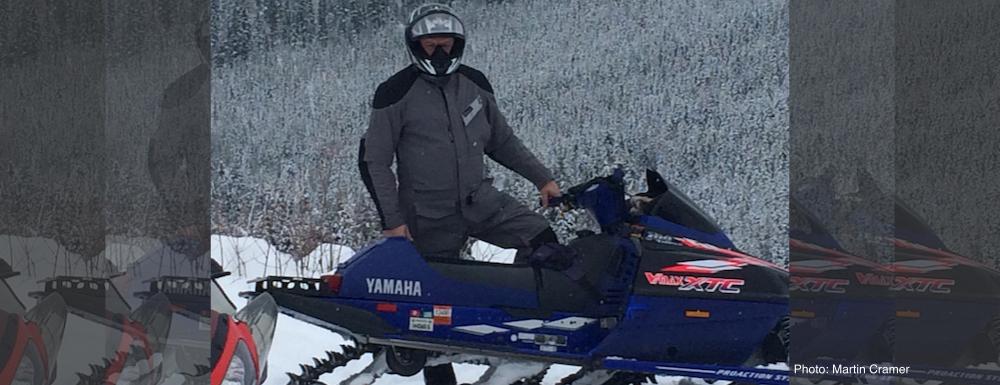A Simple Recipe for the Ultimate (arguably best-ever…) Snowmobile Suit*
Start with a merino wool base layer. We sell this but Smartwool and many other companies offer similar. And if you can’t deal with wool, there are excellent synthetics these days. We sell this made in USA one and several others. Skip the cotton boxers, briefs or t shirts. Commando is (works and feels) best for this end-use.
Over the merino, either microfiber, jeans or fleece pants, depending on temperature, wind and length of exposure. Or even a mix of all three if you can get the layering fits correct. You’ll want something semi-slippery which will smoothly and easily glide over your merino base layer because this provides maximum low-fatigue freedom of movement. It’s also got to be highly breathable. Remember, err on the looser side, look for breathable and a bit slippery.
Side note: Loose-fitting sliding layering is extremely important. In 1999 the frozen body of expert mountain climber George Mallory was found on the side of Mt. Everest. Back in 1924 he and his partner Irvine were attempting to be the first to summit the world’s highest mountain. After the body was recovered his period clothing and gear were analyzed. Researchers found the combination of cotton and wool layers he wore (which were the very highest tech then available) provided this exact ‘slippery’ quality which yielded the most fatigue-free layering solution for working and climbing in this extremely cold and windy environment.
Over your mid layer add a down or synthetic ‘puffy’, who’s thickness can vary depending (again) on temperature and anticipated length of exposure. Over everything goes a customized Aerostich R-3 light tactical with its impact armor removed, and after being altered as follows:
This example (mine) was about $1,700. I started with an R-3 one size larger than what I wear during the spring, summer, and fall for commuting. Then I shortened its legs and sleeves slightly, added an extended side gusset on both sides (from elbow to thigh) to make it bigger around my middle and allow much extra insulation, and then added the ‘forward rotated sleeves’ and ‘back panel ellipse’ appreciated by riders of sport bikes with low handlebars and high footrests.
All this leaves plenty of room for moving around freely and adding or subtracting insulation layers as needed. This example is the second one of these suits I’ve owned, and at my age now (68) I’ll hopefully wear it for ten or more winters ahead. The first one of these winter R-3’s was made for me five years ago when we were doing our Zero Below Zero project. This one is brand new, and in a few weeks, I’ll probably clean up the ZBZ one which was made slightly smaller and sell it on our sale list as a ‘product development sample’.
What this all means is I have one oversize suit for winter (which around here means three months of very cold winter weather -- Duluth is statistically the coldest or second coldest city in the lower 48 states, with periods of weeks each winter when the ambient temp may not get above 0ºf -- and another suit for the rest of the year. This year that regular R-3 is going to be seven or eight years old and is still working fine.
It took me years (decades) to conclude that I needed to have two of these suits to be able to ride year-around in comfort here. What I learned along the way is a lightly altered R-3 lIght combined with some good base layers make an R-3 light just about the world’s finest snowmobile suit. Or winter extreme exposure suit for watching the Green Bay Packers during the playoffs at Lambeau Field in January. Or for snow blowing a foot of snow off your driveway at night in a stiff wind. So, if you have the money, try one. We’d appreciate your business, especially at this ‘slower’ time of the year. Note that our fit-experts will set you up with the exact correct size 97% of the time (or some similarly high percentage), and if it doesn’t fit, you may send it back for a full no-questions-asked refund within thirty days of receiving it. Once you have it, you’ll use it more than you expected to. I have.
Mr. Subjective, 1-15-22
*Also, downhill skiing (especially deep powder) and ice fishing. Can’t forget ice fishing.

